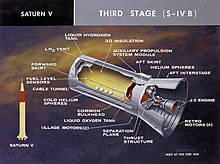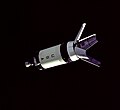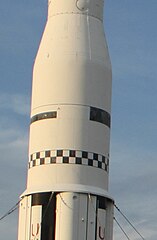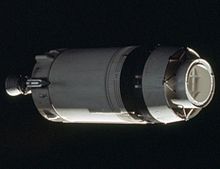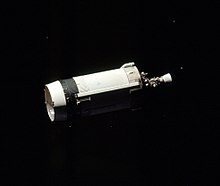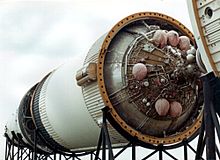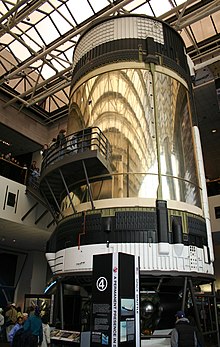
The Apollo program,also known as Project Apollo,was the United States human spaceflight program carried out by the National Aeronautics and Space Administration (NASA),which succeeded in preparing and landing the first men on the Moon from 1968 to 1972. It was first conceived in 1960 during President Dwight D. Eisenhower's administration as a three-person spacecraft to follow the one-person Project Mercury,which put the first Americans in space. Apollo was later dedicated to President John F. Kennedy's national goal for the 1960s of "landing a man on the Moon and returning him safely to the Earth" in an address to Congress on May 25,1961. It was the third US human spaceflight program to fly,preceded by the two-person Project Gemini conceived in 1961 to extend spaceflight capability in support of Apollo.

The Apollo Lunar Module,originally designated the Lunar Excursion Module (LEM),was the lunar lander spacecraft that was flown between lunar orbit and the Moon's surface during the United States' Apollo program. It was the first crewed spacecraft to operate exclusively in the airless vacuum of space,and remains the only crewed vehicle to land anywhere beyond Earth.
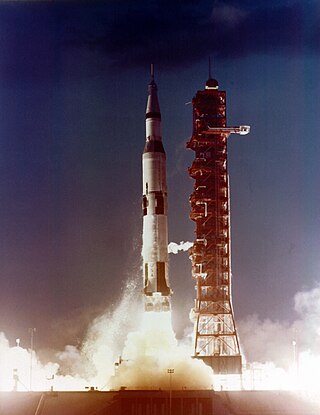
Apollo 4,also known as SA-501,was the uncrewed first test flight of the Saturn V launch vehicle,the rocket that eventually took astronauts to the Moon. The space vehicle was assembled in the Vehicle Assembly Building,and was the first to be launched from Kennedy Space Center (KSC) in Florida,ascending from Launch Complex 39,where facilities built specially for the Saturn V had been constructed.

Apollo 5,also known as AS-204,was the uncrewed first flight of the Apollo Lunar Module (LM) that would later carry astronauts to the surface of the Moon. The Saturn IB rocket bearing the LM lifted off from Cape Kennedy on January 22,1968. The mission was successful,though due to programming problems an alternate mission to that originally planned was executed.

Apollo 6,also known as AS-502,was the third and final uncrewed flight in the United States' Apollo Program and the second test of the Saturn V launch vehicle. It qualified the Saturn V for use on crewed missions,and it was used beginning with Apollo 8 in December 1968.

AS-201,flown February 26,1966,was the first uncrewed test flight of an entire production Block I Apollo command and service module and the Saturn IB launch vehicle. The spacecraft consisted of the second Block I command module and the first Block I service module. The suborbital flight was a partially successful demonstration of the service propulsion system and the reaction control systems of both modules,and successfully demonstrated the capability of the command module's heat shield to survive re-entry from low Earth orbit.
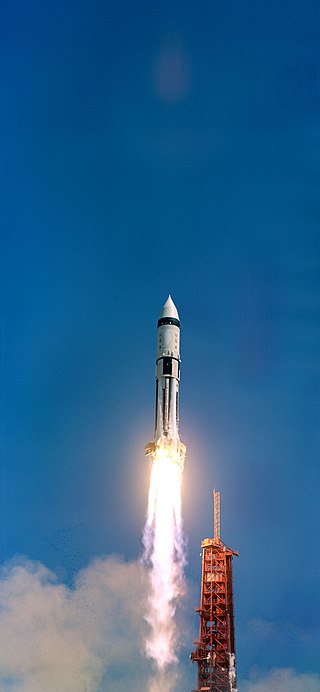
AS-203 was an uncrewed flight of the Saturn IB rocket on July 5,1966. It carried no command and service module,as its purpose was to verify the design of the S-IVB rocket stage restart capability that would later be used in the Apollo program to boost astronauts from Earth orbit to a trajectory towards the Moon. It achieved its objectives,but the stage was inadvertently destroyed after four orbits.

AS-202 was the second uncrewed,suborbital test flight of a production Block I Apollo command and service module launched with the Saturn IB launch vehicle. It was launched on August 25,1966,and was the first flight which included the spacecraft guidance,navigation control system and fuel cells. The success of this flight enabled the Apollo program to judge the Block I spacecraft and Saturn IB ready to carry men into orbit on the next mission,AS-204.

The Apollo spacecraft was composed of three parts designed to accomplish the American Apollo program's goal of landing astronauts on the Moon by the end of the 1960s and returning them safely to Earth. The expendable (single-use) spacecraft consisted of a combined command and service module (CSM) and an Apollo Lunar Module (LM). Two additional components complemented the spacecraft stack for space vehicle assembly:a spacecraft–LM adapter (SLA) designed to shield the LM from the aerodynamic stress of launch and to connect the CSM to the Saturn launch vehicle and a launch escape system (LES) to carry the crew in the command module safely away from the launch vehicle in the event of a launch emergency.

The Saturn IB(also known as the uprated Saturn I) was an American launch vehicle commissioned by the National Aeronautics and Space Administration (NASA) for the Apollo program. It uprated the Saturn I by replacing the S-IV second stage,with the S-IVB. The S-IB first stage also increased the S-I baseline's thrust from 1,500,000 pounds-force (6,700,000 N) to 1,600,000 pounds-force (7,100,000 N) and propellant load by 3.1%. This increased the Saturn I's low Earth orbit payload capability from 20,000 pounds (9,100 kg) to 46,000 pounds (21,000 kg),enough for early flight tests of a half-fueled Apollo command and service module (CSM) or a fully fueled Apollo Lunar Module (LM),before the larger Saturn V needed for lunar flight was ready.
The Saturn I was a rocket designed as the United States' first medium lift launch vehicle for up to 20,000-pound (9,100 kg) low Earth orbit payloads. The rocket's first stage was built as a cluster of propellant tanks engineered from older rocket tank designs,leading critics to jokingly refer to it as "Cluster's Last Stand". Its development was taken over from the Advanced Research Projects Agency in 1958 by the newly formed civilian NASA. Its design proved sound and flexible. It was successful in initiating the development of liquid hydrogen-fueled rocket propulsion,launching the Pegasus satellites,and flight verification of the Apollo command and service module launch phase aerodynamics. Ten Saturn I rockets were flown before it was replaced by the heavy lift derivative Saturn IB,which used a larger,higher total impulse second stage and an improved guidance and control system. It also led the way to development of the super-heavy lift Saturn V which carried the first men to landings on the Moon in the Apollo program.
Apollo abort modes were procedures by which the nominal launch of an Apollo spacecraft,either the Saturn IB or Saturn V rocket,could be terminated. The abort of the flight allowed for the rescue of the crew if the rocket failed catastrophically. Depending on how far the flight had progressed,different procedure or modes would be used. In the history of the Apollo Program,none of the abort modes were ever used on any of the fifteen crewed Apollo spacecraft flights.
The Apollo Applications Program (AAP) was created as early as 1966 by NASA headquarters to develop science-based human spaceflight missions using hardware developed for the Apollo program. AAP was the ultimate development of a number of official and unofficial Apollo follow-on projects studied at various NASA labs. However,the AAP's ambitious initial plans became an early casualty when the Johnson Administration declined to support it adequately,partly in order to implement its Great Society set of domestic programs while remaining within a $100 billion budget. Thus,Fiscal Year 1967 ultimately allocated $80 million to the AAP,compared to NASA's preliminary estimates of $450 million necessary to fund a full-scale AAP program for that year,with over $1 billion being required for FY 1968. The AAP eventually led to Skylab,which absorbed much of what had been developed under Apollo Applications.
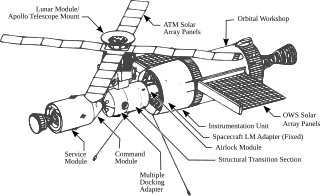
A wet workshop is a space station made from a spent liquid-propellant rocket stage. Such a rocket stage contains two large,airtight propellant tanks;it was realized that the larger tank could be retrofitted into the living quarters of a space station,while the smaller one could be used for the storage of waste. A large rocket stage would reach a low Earth orbit and undergo later modification. This would make for a cost-effective reuse of hardware that would otherwise have no further purpose,but the in-orbit modification of the rocket stage could prove difficult and expensive. As of April 2023,no wet-workshop space station has been built or flown.
Several planned missions of the Apollo crewed Moon landing program of the 1960s and 1970s were canceled,for reasons which included changes in technical direction,the Apollo 1 fire,hardware delays,and budget limitations. After the landing by Apollo 12,Apollo 20,which would have been the final crewed mission to the Moon,was canceled to allow Skylab to launch as a "dry workshop". The next two missions,Apollos 18 and 19,were later canceled after the Apollo 13 incident and further budget cuts. Two Skylab missions also ended up being canceled. Two complete Saturn V rockets remained unused and were put on display in the United States.

The Exploration Systems Architecture Study (ESAS) is the official title of a large-scale,system level study released by the National Aeronautics and Space Administration (NASA) in November 2005 of his goal of returning astronauts to the Moon and eventually Mars—known as the Vision for Space Exploration. The Constellation Program was cancelled in 2010 by the Obama Administration and replaced with the Space Launch System,later renamed as the Artemis Program in 2017 under the Trump Administration.
The Earth Departure Stage (EDS) is the name given to the proposed second stage of the Block 2 Space Launch System. The EDS is intended to boost the rocket's payload into a parking orbit around the Earth and from there send the payload out of low Earth orbit to its destination in a manner similar to that of the S-IVB rocket stage used on the Saturn V rockets that propelled the Apollo spacecraft to the Moon. Its development has been put on hold until stages capable of transferring heavy payloads to Mars are required.

The Saturn II was a series of American expendable launch vehicles,studied by North American Aviation under a NASA contract in 1966,derived from the Saturn V rocket used for the Apollo lunar program. The intent of the study was to eliminate production of the Saturn IB,and create a lower-cost heavy launch vehicle based on Saturn V hardware. North American studied three versions with the S-IC first stage removed:the INT-17,a two-stage vehicle with a low Earth orbit payload capability of 47,000 pounds (21,000 kg);the INT-18,which added Titan UA1204 or UA1207 strap-on solid rocket boosters,with payloads ranging from 47,000 pounds (21,000 kg) to 146,400 pounds (66,400 kg);and the INT-19,using solid boosters derived from the Minuteman missile first stage.

The Saturn V is a retired American super heavy-lift launch vehicle developed by NASA under the Apollo program for human exploration of the Moon. The rocket was human-rated,had three stages,and was powered with liquid fuel. Flown from 1967 to 1973,it was used for nine crewed flights to the Moon,and to launch Skylab,the first American space station.

